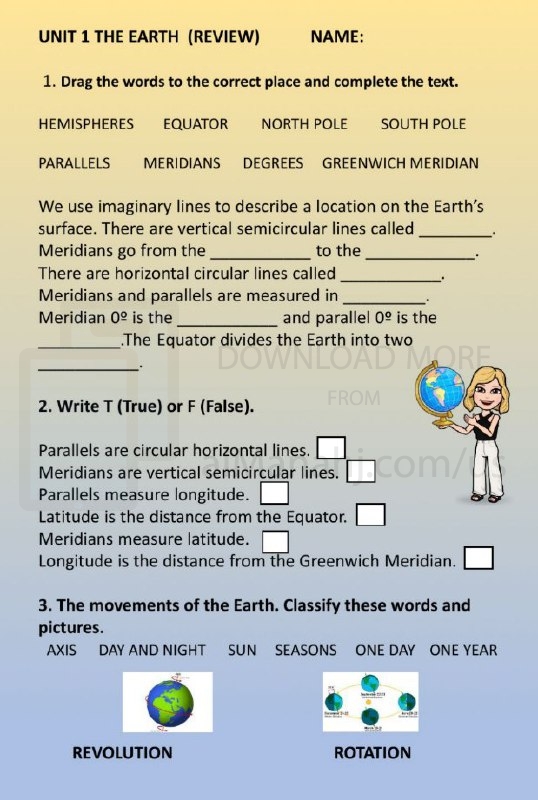| You are here: Almanahj Website ⇒ American curriculum ⇒ 4th Grade ⇒ Geology ⇒ Term 1 | ||
|---|---|---|
Worksheet about EARTHS MOVEMENTS AND LAYERS | ||
|---|---|---|
| Subject: Geology | ||
| 4th Grade | ||
| Term 1 | ||
| Year: 2023/2024 | ||
| Size: 365KB | ||
| Number of clicks: 133 | ||
| Publish date:November 22, 2023 | ||
| Added by: Eman | ||
| Last download date: 2024-09-12 08:06:26 | ||
| Updated by: Eman9966 on 2023-11-23 15:49:13 | By: theodor MAITE ESCALONA RUZ | |
| File info: Earth's Movements The Earth is in constant motion, rotating on its axis and revolving around the Sun. These movements have a profound impact on our planet, influencing the day-night cycle, seasonal changes, and the distribution of solar radiation. Rotation: The Earth rotates on its axis once every 24 hours, giving us the familiar cycle of day and night. As the Earth spins, different parts of the planet face the Sun, experiencing daylight, while others remain in darkness. This rotation is responsible for the daily patterns of temperature, light, and shadow that we experience. Revolution: The Earth also orbits the Sun once every 365.24 days, completing a full revolution. This motion is responsible for the change of seasons. As the Earth's tilt causes different parts of the planet to receive varying amounts of sunlight throughout the year, we experience the changing seasons of spring, summer, autumn, and winter. Earth's Layers The Earth is not a homogenous sphere; it is made up of distinct layers with different compositions and properties. These layers, from the innermost to the outermost, are: Inner Core: The innermost layer of the Earth is the solid inner core, composed primarily of iron and nickel. It is believed to be extremely hot, with temperatures reaching up to 5,500 degrees Celsius. The inner core's rotation is thought to generate the Earth's magnetic field. Outer Core: Surrounding the inner core is the outer core, a liquid layer of iron and nickel. This layer is less dense and hotter than the inner core, with temperatures reaching around 4,500 degrees Celsius. The outer core's movement is thought to drive Earth's magnetic field. Mantle: The mantle is the thickest layer of the Earth, accounting for about 80% of its volume. It is a viscous, solid layer of rock, composed primarily of magnesium, silicon, and oxygen. The mantle's slow movement is responsible for plate tectonics, the movement of Earth's tectonic plates. Crust: The crust is the outermost layer of the Earth, a thin, brittle shell made up of rock. It is divided into two types: continental crust, which forms the continents, and oceanic crust, which forms the ocean floor. The crust is much cooler than the Earth's interior, with temperatures ranging from near freezing to around 900 degrees Celsius. These layers, each with their unique properties, work together to make the Earth the dynamic and habitable planet we know today. The Earth's movements and layers are essential for life, influencing climate, weather patterns, and the distribution of resources. Understanding these processes is crucial for our ability to manage our planet's resources and mitigate the impacts of human activities on the Earth's environment. | ||
| Downloading link Worksheet about EARTHS MOVEMENTS AND LAYERS |
|---|
|
1700636250.pdf
The file is being prepared for download
|
| File images |
|---|
 |